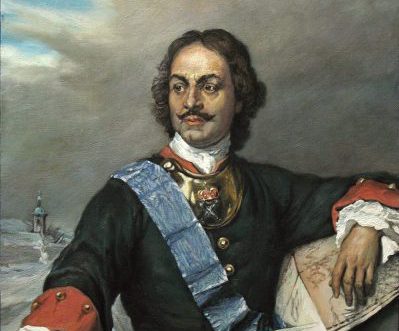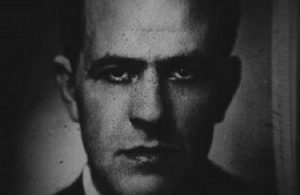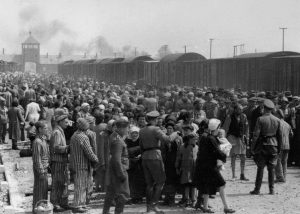Russian historian Nikolai Pogodin once said, “The Russia of today, that is to say, European Russia, diplomatic, political, military, commercial, industrial, scholastic, literary—is the creation of Peter the Great. Everywhere we look, we encounter this colossal figure, who casts a long shadow over our entire past.”1 Peter I, also known as Peter the Great, was the tsar and emperor of Russia from 1682 to 1725. He played a crucial role in westernizing Russia by changing its economy, government, culture, and religious affairs.2 By doing all of this, Russia was able to expand and become one of the most powerful countries in the eastern hemisphere.

Peter Alexeyevich was born in 1672 and was the son of Tsar Alexei Milhailovich of Russia. At the age of ten, Peter and his half-brother Ivan V both shared the title of tsar after their father had passed away. When Ivan died in 1686, Peter became the single ruler of Russia. Around this time, he began taking great interest in sailing, meeting foreigners, and military command.3 In 1695, Peter fought against the Turks, and after seeing how weak his own navy was, he sent several of his people to European maritime powers to study shipbuilding and navigation. Just two years later, Peter himself traveled around Europe, learning about Europe’s customs, military, religion, and economy. Fascinated with the foreign customs he encountered, he returned to Russia and implemented aspects of European culture into his own country.4
Upon returning to Russia, Peter began enforcing changes to break away from old Russian traditions. He ordered all of the men in the country to shave off their beards, forcing anyone who kept their beards to pay an extra tax. The old Russian calendar was replaced with the Julian calendar that the rest of Europe had adopted.5 Even Peter’s portraits were decorated with western imagery, drawing inspiration from the Romans in its allegory to emphasize his strength and power. Peter also established a new government hierarchy, allowing lower class citizens to rise in rank and become nobles. Whenever Peter was away from Russia, he would have a senate that he appointed to oversee all judicial and administrative functions. The person in charge of the senate was given the title “ober-procurator,” and was a direct agent of the tsar. In 1717, Peter created several branches in the government that specialized in managing the country’s economy, navy, and foreign affairs.6 Additionally, Peter came up with a more simplified alphabet so it would be easier to learn to read the Russian language. The new alphabet, called civil script, was used in printing out secular works for the public.7
Peter’s military conquests were also beneficial to Russia. In 1700, he waged war on Sweden in order to control the Baltic Sea. Despite some minor losses, Peter managed to best Sweden by triumphantly defending Russia against King Charles XII’s Swedish army and capturing critical Swedish ports in the Baltic Sea. The Treaty of Nystadt in 1721 gave Russia official control of several regions around the Baltic Sea, including Livonia, Ingria, and Estonia. As a result, Peter was awarded the titles Emperor, the Great, and Father of the Fatherland. Just a year later, Peter started a campaign against Persia, and he successfully held control of the ports in Baku and Derbent in the Caspian Sea. Intensive recruitment, home produced weapons, organized supplies, and having foreign officers as trainers all contributed to Russia’s military success. Having a peasant population that was willing to serve, a harsh climate, and a heavily fortified navy almost seemed to make Russia invincible.8

Starting in 1712, St. Petersburg became the capital of Russia. Peter used the city to construct palaces, churches, and government buildings in western European fashion. Its naval academy, Peter’s most successful technical school, was taught by British instructors. The city was provided with street lighting, and the Chief of Police supervised the public welfare. As part of Peter’s policy, all of the townspeople were required to wear European fashioned clothes. Peter’s reasoning for these changes can be summed up in his own words: “Even though something may be good, if it is new our people will not do it.”9 Peter did not hesitate to use force when necessary to enforce these changes. He was very strict, and both peasants and nobles worked tirelessly in their daily lives. Not only was it mandatory for parents to teach their sons about service to the country, but it was also expected for citizens to work their entire adult lives.10
All of these sudden cultural changes led to controversy within the nation. Some religious traditionalists saw Peter as a sort of Antichrist, and there were several occurrences of revolt during his reign. For example, Peter’s son, Alexei Petrovich, was charged with treason for trying to assassinate his father; he and many of his co-conspirators were executed as a result.11 While Peter had many critics, his contributions to Russia greatly outweighed any negative effects.
Peter continued to cultivate Russia until his death in 1725.12 All in all, Peter the Great’s reign saw dramatic changes in Russia and helped make it into a wealthier and powerful country. In the end, Peter the Great had brought cultural revolution to Russia, sowing the seeds for the modern Russia that we know today.
- Encyclopedia of Russian History, 2004, s.v. “Peter I,” by James R. Millar. ↵
- Encyclopedia of Russian History, 2004, s.v. “Peter I,” by James R. Millar. ↵
- Encyclopedia of Russian History, 2004, s.v. “Peter I,” by James R. Millar. ↵
- Encyclopedia of European Social History, 2001, s.v. “Peter I (1672-1725),” by Peter N. Stearns. ↵
- Encyclopedia of European Social History, 2001, s.v. “Peter I (1672-1725),” by Peter N. Stearns. ↵
- Salem Press Biographical Encyclopedia, 2016, s.v. “Peter the Great,” by Surendra K. Gupta. ↵
- Encyclopedia of Russian History, 2004, s.v. “Peter I,” by James R. Millar. ↵
- Encyclopedia of Russian History, 2004, s.v. “Peter I,” by James R. Millar. ↵
- Encyclopedia of Russian History, 2004, s.v. “Peter I,” by James R. Millar. ↵
- Encyclopedia of Russian History, 2004, s.v. “Peter I,” by James R. Millar. ↵
- Encyclopedia of Russian History, 2004, s.v. “Peter I,” by James R. Millar. ↵
- Encyclopedia of Russian History, 2004, s.v. “Peter I,” by James R. Millar. ↵



36 comments
Azariel Del Carmen
It is very interesting to hear who Peter was at the time of his rule before Russia had him and what he did that later impacted Russia in the future with other Tsars like Catherine. His desire to expand the quality of Russia, similar to Russia, his military achievements and reforms allowed Russia to be shaped very differently to the point that Russia was gaining ahead to becoming a power house in the East/West depending on where you are with other European Nations and showed that against Persia and Sweden to get control to ports and such that later increased how Russia influenced the world.
Madeline Emke
The article was very well-written and succinct. The author wrote an informative summary of Peter the Great’s transition of Russia. It’s interesting that Peter was able to notice the weakness of his navy and learn how to strengthen it by sending them to study shipbuilding and navigation. He introduced many new ideas into Russia that are intriguing, such as having all of the men shave off their beards and simplifying the Russian alphabet.
Sara Guerrero
I’ve never heard of Peter the Great but I found it interesting learning about how he changed Russia for the better. He brought new ideas and I think that kind of scared the people which led to his son being accussed of treason and others, but Peter the Great cultivated Russia to become a stronger in wealth and power. Very interesting character, great job summarizing his story!
Aaron Sandoval
This article was very well done and did a good job of covering Peter the Great. Before reading this article, I knew very little about Peter beside the fact that he was Great, but I never really understood the context as to why he was referred to as being great. This article did a good job of giving context as to why he earned his nickname, and many of the advancements that he made that allowed Russia to be prosperous.
Lesley Martinez
I’ve heard the name Peter the Great, but I was not fully aware of his role in westernizing Russia. It’s quite interesting that Peter was able to recognize the weakness of his navy and sent them to study shipbuilding and navigation. He introduced many new concepts into Russia that are intriguing, such as having all of the men shave off their beards and simplifying the Russian alphabet. Even though he may have brought a cultural revolution to Russia, I can see how controversy can arise from his behavior. Great and informative article!
Nelly Perez
Peter the Great was interesting to learn about. He helped expand Russia and create new relationships with foreign countries. He earned the title of tsar at a young age and shared it with his brother until it got split for him to rule. He made changes to his country after exploring European customs to implement on Russia. Most men had their lifestyles changed.
David Castaneda Picon
This is a very informative and enjoyable article to read. This was my first time reading about this character (Peter the Great) of Russian history, I believe it was amazing all the things he did for his country, that really showed that he cared for his country and wanted to make Russia better. Just the fact of him studying about foreign cultures and learning new thing to bring to his country and also change the alphabet just to make it easier to understand for other parts of the world show his interest in the prosperity of Russia. Now I can see why he was one of the most outstanding rulers of Russia.
Hali Garcia
Great job!!! I have heard about Peter the Great but I did not know much about him until I read this article. It is astonishing how progressive he was and the lengths he took to get his people to make these changes. What I find the most interesting is how he had allowed the lower class to become nobles and created a senate to make decisions when he was gone. Something that shocked me was when he had his son executed for attempting to assassinate him. Overall, this is a very informative article and I enjoyed reading this.
Antonio Holverstott
Peter the Great’s embrace of Western European culture made Russia more receptive to ideologies from that region after Peter’s rule such as Catherine’s embrace of the Enlightenment and more politically active in the affairs of Western Europe, especially during the First World War where as a result of Russia’s involvement in the First World War, the Germans used Vladimir Lenin, an exiled philosopher, to go back to Russia in order to start a revolution to overthrow the tsar. Lenin succeeded at both his and the German government’s goal.
Samuel Vega
This was an informative article on Peter the Great. He had insight and a plan to build his country. He saw what wasn’t working such as his navy and then found solutions to fix the problem. He turned to Europe for many of those solutions. It seems that Peter the Great still ruled with a heavy hand; but didn’t have the violence and death for those he ruled. He left a lasting legacy.